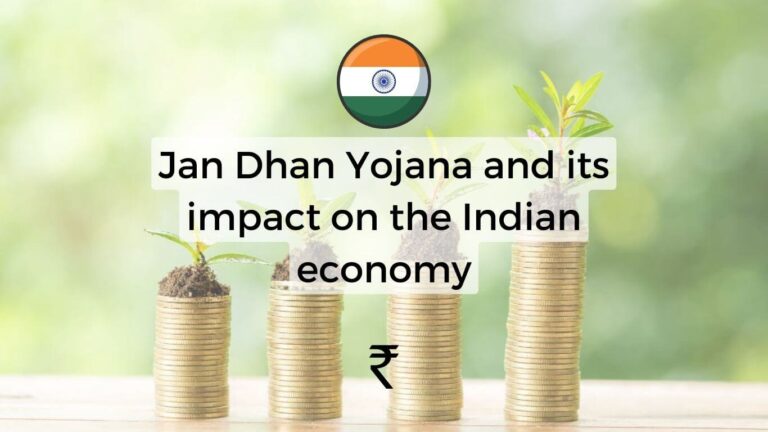Jan Dhan Yojana, launched by the Indian government in 2014, is a financial inclusion scheme aimed at providing access to banking facilities to the country’s unbanked population. The scheme focuses on bringing people with low-income and marginalized sections of society into the formal banking system. Thereby promoting financial inclusion and economic development.
What is Pradhan Mantri Jan Dhan Yojana
The Pradhan Mantri Jan Dhan Yojana was launched on August 28, 2014, with the aim of providing banking facilities to all households in the country. The scheme has three pillars: universal access to banking facilities, financial literacy, and creating a credit guarantee fund for providing loans to small businesses. The aim of this plan is to promote financial inclusion, social security, and digital India.
The scheme has been successful in achieving its objectives, with more than 41 crore bank accounts opened and over Rs. 1.54 lakh crore deposited by account holders as of March 2021. Additionally, the scheme has helped in the digitization of the banking sector and has enabled the government to provide direct benefit transfers to the beneficiaries, resulting in reduced leakage and corruption.
The impact of the PMJDY on the Indian economy has been significant. The scheme has provided access to formal banking facilities to the country’s unbanked population. Which has led to an increase in financial inclusion and empowerment of people with low income. The increased use of formal banking services has helped in the generation of savings, increased investments, and better credit facilities, thereby boosting economic growth.
This article will examine the impact of the PMJDY on the Indian economy, the challenges faced in its implementation, and the way forward for the scheme to achieve its goals of financial inclusion and promoting economic development.
Jan Dhan Yojana Account Opening Online
To open a Jan Dhan Yojana account online, follow these steps:
- Visit the official website of the bank where you want to open the account.
- Look for the ‘Jan Dhan Yojana’ section on the website and click on it.
- You will be directed to an application form. Fill in all the required details in the form, such as your name, address, date of birth, occupation, and other details.
- Upload the necessary documents, such as your identity proof, address proof, and photographs.
- Once you have filled in all the required details, submit the application form.
- After submitting the application, you will receive a reference number that you can use to track the status of your application.
Alternatively, you can also visit the website of the National Payments Corporation of India (NPCI). Look for the Jan Dhan Yojana section. From there, you can select the bank where you want to open an account and follow the same steps as mentioned above.
It is important to note that some banks may not allow you to open a Jan Dhan Yojana account online and may require you to visit a branch in person. Therefore, it is advisable to check with the bank’s website or customer care before initiating the online application process.
Jan Dhan Yojana Benefits
This scheme aims to provide access to banking services and financial literacy to the unbanked population of India. Jan Dhan Yojana has been recognized as one of the world’s most significant financial inclusion initiatives, with over 40 crore accounts opened and INR 1.3 lakh crore deposited.
The Jan Dhan Yojana Benefits List is as follows:
No minimum balance requirement
One of the significant features of Jan Dhan Yojana is that there is no minimum balance requirement to open an account. This feature makes it easier for the low-income population to access banking services, as they do not have to worry about maintaining a minimum balance or paying penalties for non-maintenance of the minimum balance.
Overdraft facility
Jan Dhan Yojana accounts come with an overdraft facility of up to INR 10,000. The overdraft facility is available to individuals who have had a satisfactory transaction record of six months. This facility is particularly useful for the unbanked population as it provides them with access to credit and helps them meet their emergency financial needs.
Accidental insurance cover
Under PMJDY, individuals are provided with accidental insurance coverage of up to INR 2 lakh. This insurance cover provides financial protection to the account holder’s family in case of accidental death or permanent disability.
Direct Benefit Transfer of Jan Dhan Yojana
Pradhan Mantri Jan Dhan Yojana accounts are linked to the government’s Direct Benefit Transfer (DBT) scheme. This scheme allows individuals to receive various government subsidies and welfare benefits directly into their bank accounts. The DBT scheme has helped in reducing leakages in welfare schemes and has ensured that the benefits reach the intended beneficiaries.
RuPay Debit card
Jan Dhan Yojana accounts come with a RuPay debit card, which can be used to withdraw cash from ATMs and make cashless transactions. The debit card enables the account holder to access banking services conveniently and helps them transition to a cashless economy.
Mobile banking
Jan Dhan Yojana accounts are enabled for mobile banking, which allows individuals to access banking services through their mobile phones. The mobile banking feature provides the account holder with easy and convenient access to their bank account and helps them save time and money.
In conclusion, Jan Dhan Yojana has been successful in providing access to banking services and financial literacy to the unbanked population of India. The scheme’s features, such as no minimum balance requirement, overdraft facility, accidental insurance cover, direct benefit transfer, debit card, and mobile banking, have made it easier for the low-income population to access banking services and have helped them transition to a cashless economy.
Implementation of Pradhan Mantri Jan Dhan Yojana
Implementation of Jan Dhan Yojana is a critical aspect of its success in achieving its goals of financial inclusion and economic development. The scheme was launched in August 2014 by Prime Minister Narendra Modi to provide access to basic banking services to the unbanked population of India. Here is an overview of the implementation of the Jan Dhan Yojana:
Enrollment Process
The government of India and its partner banks took an ambitious approach to enroll people in the scheme. The enrollment process was conducted through a massive campaign across the country, with camps organized at the village level. Door-to-door campaigns were also organized to encourage people to enroll in the scheme. The scheme required minimal documentation, and account holders were required to provide only their Aadhaar card and PAN card or a declaration if they did not have a PAN card.
Financial Literacy
One of the essential components of the scheme was to provide financial literacy to its beneficiaries. Financial education can be a game-changer for the unbanked population, as it equips them with the necessary knowledge and skills to manage their finances effectively. Under JDY, the government and its partner banks provided financial literacy camps to account holders to ensure that they understand the basics of banking, including the use of ATM cards, online banking, and mobile banking.
Insurance Coverage
Another critical component of the Jan Dhan Yojana was to provide insurance coverage to the account holders. The scheme offered a life insurance cover of Rs. 30,000 and an accidental insurance cover of Rs. 2 lacks to the account holders. This was a significant step towards providing financial security to the beneficiaries and their families.
Direct Benefit Transfer
Jan Dhan Yojana played a crucial role in promoting Direct Benefit Transfer (DBT) in India. DBT is a mechanism where the government transfers subsidies and other welfare benefits directly to the bank accounts of the beneficiaries. With the help of Jan Dhan Yojana, the government could effectively implement DBT, which has helped to eliminate corruption, leakages, and delays in the delivery of benefits.
Financial Inclusion and Economic Growth
Jan Dhan Yojana has been instrumental in promoting financial inclusion in the country. According to official data, more than 43 crore accounts were opened under the scheme till 30th June 2021, and the total balance in these accounts was more than Rs. 1.40 lakh crore. Financial inclusion has led to increased access to credit, insurance, and other financial services, which has promoted entrepreneurship and economic growth.
In conclusion, the implementation of PMJDY has been a significant success in promoting financial inclusion in India. The scheme has enabled the unbanked population to access basic banking services and has provided them with financial security and economic opportunities. The scheme has also been instrumental in promoting Direct Benefit Transfer. Which has helped to eliminate corruption, leakages, and delays in the delivery of benefits.
Impact of Jan Dhan Yojana on the Indian Economy
Jan Dhan Yojana has been one of the most significant financial inclusion initiatives launched in India. The scheme, launched in 2014, aims to provide banking facilities to the country’s unbanked population. The program’s implementation has had a significant impact on the Indian economy. In this section, we will discuss the impact of the Pradhan Mantri Jan Dhan Yojana on the Indian economy.

Financial Inclusion
The primary objective of Jan Dhan Yojana is to promote financial inclusion in the country. The scheme has been successful in bringing a large number of unbanked people into the banking system. According to the Ministry of Finance, as of March 2021, over 43 crore accounts have been opened under the scheme, with a total balance of over Rs. 1.3 lakh crore. The success of PMJDY in promoting financial inclusion has had a positive impact on the Indian economy.
Direct Benefit Transfer (DBT)
Another significant impact of Jan Dhan Yojana on the Indian economy is the increased adoption of the Direct Benefit Transfer (DBT) system. DBT is a mechanism for transferring subsidies and other welfare benefits directly to the bank accounts of beneficiaries. With the implementation of the Jan Dhan Yojana, the number of bank accounts linked to the DBT system has increased significantly. This has helped in reducing leakages and increasing the efficiency of welfare schemes.
Increased Banking Penetration
Jan Dhan Yojana has helped in increasing the penetration of banking services in the country. The scheme has led to the opening of bank accounts in rural areas, where banking services were not available earlier. The increased banking penetration has had a positive impact on the Indian economy by providing people with access to formal credit, which can help in boosting economic growth.
Encouraging Savings
Jan Dhan Yojana has been successful in encouraging savings among the unbanked population of the country. With the availability of banking services, people have started depositing their savings in banks. This has not only helped in reducing the dependence on informal sources of credit but has also led to an increase in the availability of funds for banks. Which can be used for lending to productive sectors of the economy.
Boosting Entrepreneurship
Jan Dhan Yojana has also had a positive impact on entrepreneurship in the country. With the availability of formal credit, entrepreneurs, especially those in rural areas, have access to the required funds for starting or expanding their businesses. This has helped in creating employment opportunities and boosting economic growth.
Financial Literacy
Jan Dhan Yojana has also been instrumental in promoting financial literacy among the unbanked population of the country. The scheme has helped in educating people about the benefits of saving, the importance of credit, and the various financial services offered by banks. This has helped in increasing the awareness of the unbanked population about the formal financial system and its benefits.
In conclusion, Jan Dhan Yojana has had a significant impact on the Indian economy by promoting financial inclusion, encouraging savings, boosting entrepreneurship, and increasing the penetration of banking services. The success of the scheme is reflected in a large number of bank accounts opened under it and the increased adoption of the DBT system. The implementation of PMJDY has helped in reducing leakages in welfare schemes and increasing the efficiency of the government’s delivery mechanisms. The scheme has also helped increase financial literacy among the unbanked population. Which is essential for promoting a financially inclusive society.
Challenges of the Jan Dhan Jojana
The Jan Dhan Yojana has been instrumental in bringing millions of unbanked citizens into the banking fold. However, the scheme has also several challenges that need to be addressed for its success. Some of the significant challenges of the Jan Dhan Yojana are:
Financial Literacy
Financial literacy is a significant challenge available for the PMJDY scheme. Many beneficiaries of the scheme are not aware of the various banking services offered to them, such as loans, overdraft facilities, and insurance products. Therefore, there is a need for financial literacy campaigns to educate the beneficiaries on the benefits of the scheme and how to use it effectively.
Low Utilization
While Jan Dhan Yojana has been successful in opening bank accounts, the utilization of the scheme’s benefits has been low. According to reports, many beneficiaries have not used their accounts due to a lack of knowledge about the services offered or the difficulty in accessing the banking facilities. Therefore, the government needs to improve awareness and accessibility to encourage more utilization of the scheme.
Maintenance of Accounts
Another challenge of JDY is the maintenance of accounts. While the scheme encourages the opening of bank accounts, many beneficiaries lack the resources to maintain them, leading to a high number of dormant accounts. Additionally, the banks also face difficulties in maintaining the accounts, particularly in remote and rural areas. Which requires significant investment in infrastructure.
Security Concerns of Jan Dhan Yojana
Jan Dhan Yojana has also faced security concerns. Since the scheme involves the opening of bank accounts by individuals with minimal documentation, there is a risk of fraudulent activity. Additionally, cyber threats to the banking system have also increased in recent years. Which poses a risk to the security of the scheme.
Connectivity
Finally, connectivity remains a big challenge for PMJDY in rural areas, which can affect the accessibility of banking services. Poor connectivity and infrastructure can lead to difficulty in accessing banking services, leading to low utilization of the scheme. Therefore, the government needs to invest in better connectivity and infrastructure to ensure the success of the scheme in rural areas.
In conclusion, the PMJDY has been a revolutionary scheme in bringing financial inclusion to millions of unbanked citizens in India. However, there are still several challenges that need to be addressed for the scheme’s success, including financial literacy, low utilization, maintenance of accounts, security concerns, and connectivity. Addressing these challenges is essential to ensure the scheme’s long-term success and impact on the Indian economy.
Conclusion
In conclusion, PM Jan Dhan Yojana has been a significant initiative toward financial inclusion in India. It has enabled millions of previously unbanked people to access basic banking services and government welfare schemes. The program has also led to a reduction in leakages in the welfare system, as direct benefit transfers are now made to the beneficiaries bank accounts. Additionally, the creation of bank accounts has enabled the government to identify and weed out duplicate and fake accounts, thus reducing the risk of fraud and mismanagement of government funds.
The implementation of this scheme has not been without its challenges, particularly in reaching out to remote and difficult-to-access areas. Also, ensuring the sustainability of the accounts opened. Despite these challenges, the program has made significant progress toward financial inclusion in India and has had a positive impact on the country’s economy. The program has not only expanded the customer base for banks but has also helped to increase savings. It also promoted a savings culture among the previously unbanked population.
Pradhanmantri Jan Dhan Yojana
The government’s efforts to create awareness of the program, encourage participation, use technology to make banking services accessible, and partner with banks ensured effective implementation and contributed to the success of Pradhan Mantri Jan Dhan Yojana. Going forward, it is important for the government to continue to monitor and address the challenges faced by the program. Particularly in ensuring the sustainability of the accounts opened and the provision of additional financial services such as insurance and credit.
Overall, JDY has been a game-changer in the area of financial inclusion in India. The program has helped to bring previously unbanked individuals into the formal financial system. Which has not only benefited the individuals themselves but also the broader economy. With continued efforts and support, it has the potential to create a more financially inclusive and economically prosperous India.
References
- Government of India. (2014). Prime Minister Jan Dhan Yojana Official Website.
- Reserve Bank of India. (2018). Financial Inclusion in India.
- Dubey, S. K., & Sankar, D. (2017). Role of Jan Dhan Yojana in Financial Inclusion and Inclusive Growth in India. The Journal of Developing Areas, 51(1), 143-156.
- Kaur, G. (2018). Impact of Jan Dhan Yojana on Financial Inclusion in India. International Journal of Research in Finance and Marketing, 8(5), 1-8.
- Kumar, S. (2017). Jan Dhan Yojana: A Tool for Financial Inclusion. Journal of Economic and Social Development, 13(2), 127-140.
- Mishra, D. K. (2016). Jan Dhan Yojana and Financial Inclusion in India. International Journal of Innovative Research and Development, 5(3), 90-96.
- Sahoo, A. K. (2015). Financial Inclusion in India: With Special Reference to Jan Dhan Yojana. International Journal of Social and Economic Research, 5(3), 70-83.
- Singh, J., & Bhardwaj, M. (2017). Jan Dhan Yojana: A Step towards Financial Inclusion in India. International Journal of Scientific Research and Management, 5(4), 6201-6207.
- World Bank. (2019). Global Findex Database.
Credits
- Featured Image: Image by jcomp on Freepik
- PMJDY Logo From Official Website
Also, check out our review of Jeevan Jyoti Bima Yojana.



